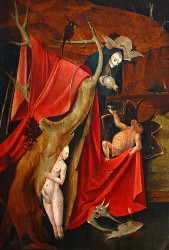
Fraenger 1963
“Ein Leitwort Jacob Grimms zur Auslegung der Lissaboner ‘Versuchungen des Hl. Antonius’” (Wilhelm Fraenger) 1963
[in: Wilhelm Fraenger and Wolfgang Steinitz (eds.), Jacob Grimm zur 100. Wiederkehr seines Todestages – Festschrift des Instituts für deutsche Volkskunde an der Deutschen Akademie der Wissenschaften zu Berlin, Berlin, 1963, pp. 240-290 (= Deutsches Jahrbuch für Volkskunde, Band 9, 1963)]
[Reprinted with slight alterations in: Castrum Peregrini, Sonderheft LVIII, Amsterdam, 1963, pp. 5-79, under the title “’Das Lied des Moses’ als Zentralmotiv der Lissaboner ‘Versuchungen des St. Antonius’ von Hieronymus Bosch”]
[Reprinted in Fraenger 1975: 435-465]
[Also mentioned in Gibson 1983: 106 (E195)]
Fraenger claims to have found Bosch’s source of inspiration (under the influence of Jacob van Aelmangien) for the interior panels of the Lisbon St Anthony triptych in Moses’ Canticle (Deuteronomy 32: 15-33). Although Athanasius’ vita of St Anthony has also inspired the triptych’s spirit, the separate scenes were not directly influenced by this text. The designer of the triptych must have been a converted Jew, namely Jacob van Aelmangien. The triptych’s esoteric elements, including the important frog motif, point to the ideas of a sect that apparently was in conflict with a competing sect.
In the course of his argument Fraenger more than once passes (often not unjust) criticism on Bax’ germanistisch-volkskundige approach, on Combe’s alchemical interpretations and on Wertheim-Aymès’ anthroposophic Rosicrucian ideas. At the end of his text Fraenger also focuses on the Abigail and David panel, according to Fraenger a copy of a lost Bosch original.
[explicit 10th April 2016]